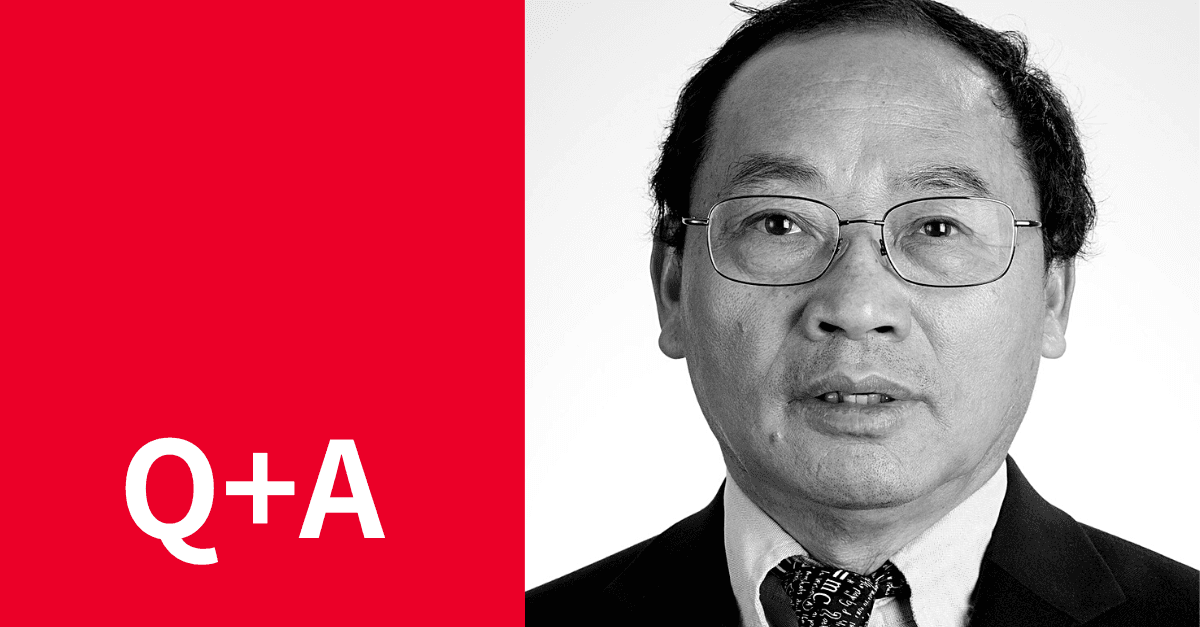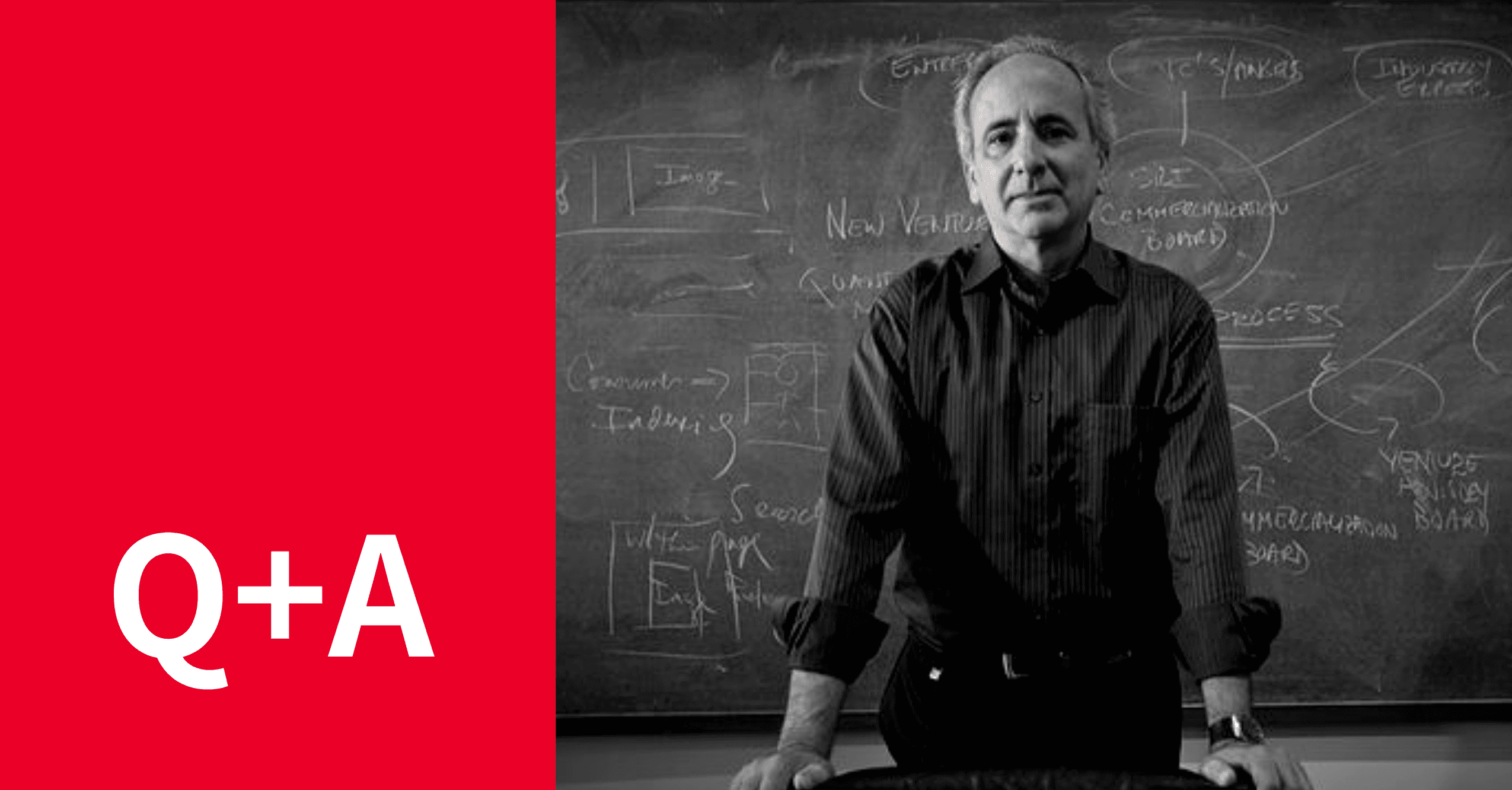Q&A with Dr. Zhifeng Ren
Tell us about yourself – what is your background in and how did you end up in your current position?
My educational background is in materials science for my Masters degree, and superconductivity for my PhD. As a Masters student in 1986, I saw Professor Paul Chu discover the yttrium-barium-copper oxide-123 compound, a ceramic superconductor capable of transmitting electricity at a much more easily achieved temperature of 93 Kelvin, above the boiling point of liquid nitrogen. This astonishing discovery was a huge deal at the time and opened up a whole new realm of research and promising applications for superconductors. When it came time to choose a focus for my PhD program, I attended the Institute of Physics, Chinese Academy of Sciences in Beijing. I knew I wanted to be focused on condensed matter physics and superconductors.
I came to the United States after completing my PhD, and was a postdoctoral researcher at State University of New York at Buffalo (SUNY-Buffalo), and later accepted an Associate Professor position at Boston College in 1999. In 2011, while at Boston College, the chair of the physics department invited Professor Chu to give a talk on superconductivity to celebrate the 100th anniversary of the discovery of superconductivity by Heike Kamerlingh Onnes.
I remember scheduling a brief conversation with Paul when he was at BC to talk with him about my research: here was someone who made such a monumental contribution to my own path and to the field of study overall – I had to meet with him. We spoke about our respective research going on at the time, which for me was aligned carbon nanotube arrays. After he came back to University of Houston, he called me and asked me whether I am movable if there is an irrefusable offer. I said yes.
Armed with that knowledge, Paul put together the appropriate requests through his program. Two years later, I accepted an offer at the University of Houston. I was somewhat awestruck—this famous person is offering me to be one of his colleagues? I couldn’t say no. Which leads me to where I am today. Currently, I am a professor at the University of Houston in the Physics Department and serve as the MD Anderson Chair Professor. Starting in September 2023, I will occupy a new chair named the May and Paul Chu Chair Professor, a tremendous contribution by Professor Chu on top of his amazing scientific works.
Can you tell us about the Texas Center for Superconductivity at U of H?
The Texas Center for Superconductivity at the University of Houston (TcSUH) was born out of Dr. Paul Chu’s work. Immediately after his paper on the discovery of Yttrium Barium Copper Oxide with superconducting transition temperature at 93 Kelvin was published in 1986, he received a number of offers from many universities, but he decided to stay in Houston. The university was awarded grants and funding from private, state, and federal sources to construct a building and assemble a faculty focused on fundamental and applied superconductor research. The program has since grown to involve energy materials including thermoelectric materials, batteries, hydrogen, and others. We have students and faculty from five departments: physics, chemistry, mechanical engineering, electrical engineering, and chemical engineering, all tackling challenges in interdisciplinary ways.
You were part of the group that discovered aligned carbon nanotubes—can you go into some detail about what they are and how they have changed material science?
Like a lot of great science, it was a complete accident.
In 1996, I was working on high temperature superconductivity at SUNY-Buffalo, but I was also trying to broaden my research areas. There is a super-hard material, cubic carbon nitride, C3N4, that is predicted to be harder than diamond by Dr. Marvin Cohen at University of California at Berkeley. I started doing experimental research on synthesizing it and got so wrapped up in it, that I wanted to try to make it to prove whether the prediction is right or wrong. At the time, we were using nitrogen gas and methane in a process called chemical vapor deposition, which uses a chemical reaction to make the predicted C3N4. We were able to produce some tiny, silvery-gray, micron-sized crystals but weren’t able to confirm their structure nor their hardness.
Hitting a wall, I reached out to my late professor Jui H. Wang, and he reminded me that the two gasses that I was using are both very difficult to break down into ions and recommended that I change the gas mix. We tried changing to ammonia to provide the nitrogen and acetylene for the carbon because of the easy-to-break double carbon bonds. After running the experiment with the new gasses, it was immediately clear that we were on to something very different. Instead of the gray color we saw previously, we saw the whole substrate become superblack.
We took our samples and ran them through an electron scanning microscope, and we saw a forest-like structure! We knew that it couldn’t be C3N4 because of this structure. It had to be carbon-based. Also, we knew that this, very clearly, wasn’t how graphite appears but had to be something entirely different like a fiber or a nanotube. I went and did some research into who was publishing or working with carbon nanotubes and saw that there was some work since 1991 when carbon nanotubes were discovered by Dr. Sumio Iijima in Japan, but they had a different structure and unpromising results. We felt what we were looking at were aligned carbon nanotubes.
We took what we had, wrote up our process and results, and submitted it to Nature; about one week later we heard back saying that they weren’t interested. I was a little bit disappointed, but I understood—we were doing something entirely new. I took the paper, revised it, and resubmitted it to Science. We very quickly heard back, but this time it was good news. They were sending it for an in-depth evaluation and outside review, which meant you were likely to get accepted. When the review came back, they noted that they needed more evidence that they were hollow and not just thick fibers. I contacted a colleague at Sandia National Lab who had access to a transmission electron microscope. They ran some tests, verified that they were bamboo-like, and hollow as we thought. With this evidence, Science was satisfied and we were published shortly after, which opened up a brand-new field and attracted thousands of scientists into the field.
At the time, Samsung R&D division was extremely interested in it about how they could use the aligned nanotubes to create new television flat displays (which were eventually eclipsed by LED technologies), but carbon nanotubes are used in many things from increasing electrical conductivity to making paint to creating rope fibers. They are extremely strong, lightweight, and very versatile.
Can you tell us about some of your work on thermoelectrics and how nanoparticles can be used?
After my paper was published by Science, carbon nanotubes dictated a lot of my research until around 2003 when I was at a conference at Duke University. The United States Department of Defense wanted to set up a national research center to concentrate all work on nanotechnology for military purposes. This meeting was informational on what could be done and what they were looking for.
During a break, I ran into someone who looked familiar, but neither of us could think of where we knew one another from. We traced back through our academic careers, and it turns out we lived on the same floor when we were in Master degree graduate study together at the Huazhong University of Science and Technology in Wuhan, China! It was such a funny happenstance to reconnect like that.
He is Dr. Gang Chen, and a few months after the conference, he moved to MIT. He said that he was working on thermoelectric material to enhance the performance and needed a material scientist to work with. I happily agreed. We wrote a grant proposal to NASA in 2004 on the nanostructures of thermoelectric materials, and we successfully won it shortly after.
We worked together for a number of years, and ended up being very successful. We used bismuth telluride alloy, a material that has been used for decades in thermoelectrics. We ground the alloy into nanoparticles and then pressed them back together. We found an improvement in the thermoelectric properties of around 40%. This interaction was mainly due to a reduction in thermal conductivity, but the power factor was completely unaffected. Our paper was published in Science in 2008, and I’m immensely proud of our work. It continues to be heavily cited to this day, and attracted many scientists to this new field.
Splitting seawater through electrolysis has historically been more trouble than it's worth. What got you interested in this research area and what have you learned in your work?
When I joined the University of Houston and Texas Center for Superconductivity, I decided to broaden my research beyond thermoelectrics using the funds from grants and startup package to include hydrogen generation by water electrolysis, flexible transparent conductors, high thermal conductivity materials, nanomaterials for oil recovery, and of course superconductivity.
Hydrogen has always been interesting to me because of how clean it is as an energy source. Using hydrogen as a fuel is a clean process that also yields water is a very compact and simple solution to energy problems. Hydrogen today is most commonly made from hydrocarbons – which creates CO2 in the process. However, getting pure, green hydrogen is a challenge. The other main method of acquisition is through electrolysis. Making hydrogen from pure water is easy: you pass enough electrical power through, and it breaks down to its constituent parts, hydrogen and oxygen.
If you have enough pure water everywhere, it would be much easier to rely on large scale water electrolysis to obtain hydrogen. To your point about more trouble than it's worth, creating hydrogen from any water source takes more energy than it will produce. Those are just the laws of physics. However, fresh water is extremely limited, let alone pure water. Salt water accounts for 97% of the total water on Earth, but purifying the water via desalination takes an incredible amount of energy that will greatly offset the benefits the hydrogen could create. I wanted to work on a process that took that out of the equation, and went right from salt water to usable hydrogen.
So that is what my team at University of Houston has been working on – how to make this process as efficient as possible. Students and postdocs are looking into different catalysts that can be used to split seawater without undergoing any substantial purification processes. We’ve had a good deal of success with transition metals like iron and nickel-based catalysts, which are very efficient and less expensive to make than the current standard noble metal based catalysts.
I think that abundant hydrogen fuels are closer and more applicable than most might realize. A transformation is coming to the way we think about our energy grid. To put it simply, the current system has a great number of levers it can pull based on demand. To meet baseload demands, it runs at one level. During the day, demand goes up as we go about our lives, and the power plants pull the levers to keep up. Demand starts to scale down in the evenings, and the delta between generation and demand is small: producers want to make sure that there is always enough power. What isn’t used is either wasted or stored in short-term systems.
Renewable energy at scale is coming, most commonly in the form of solar or wind. The generation is intermittent, and removes a lot of the levers of control from our hands. These models must incorporate overproduction and massive storage systems to give us back enough control. For a city to rely on solar and wind energy, they must also plan to store staggering amounts of electricity long term. The solution that is often come to is to build gigantic batteries, either with molten salts or with lithium. Neither of these are ideal candidates: they both see degradation of energy stored over time, and are extremely expensive to build and maintain.
I believe that hydrogen is a missed opportunity as a potential storage solution. If the grid is already set up to overproduce energy for the purpose of storage, why not instead use that for intensive processes like electrolysis of seawater? Hydrogen can be created during peak solar or wind generation and then used as a fuel when generation is low. Unlike a battery, hydrogen can be stored for long periods of time and it can be transported for use elsewhere. Alternatively, it can be sold or repurposed for other industrial uses.
What are superconductors and what has been your approach to trying to uncover them?
Basically, there are four types of material: insulators, semiconductors, conductors, and superconductors. With an insulator, you can’t pass an electrical charge through the material. A semiconductor has a certain resistance property, which changes the way the electrons flow through a material. Conductors have very low resistance which creates a net loss of energy in the form of heat when a current is passed through it. This resistance also dictates how much total electricity you can put through a given material and why a power line contains much more material than the cable you use to charge your phone.
Superconductors are very special, and have a resistance value of actual zero. So long as the conditions are met for its superconductivity, the electricity will be there for a really long time. You can transmit thousands of amps over a very long distance, and you do not see the current decrease over the span of many years.
Superconductors, as they first were discovered in 1911, were observed in mercury cooled to 4.2 Kelvin. Dr. Chu discovered what are today called “high temperature superconductors,” which contrary to what the name leads you to believe, are still reaching their critical state at and above 77 Kelvin. These two temperatures are still worlds apart. High temperature superconductors can be successfully cooled with liquid nitrogen, which is very common and easy to use. What materials researchers are working on today is to create higher temperature superconductors. The easier it is to maintain a superconductive state, the more applications the material can have. Superconductors are used today in many different forms from quantum computers to MRIs.
What are some of the projects you’re working on right now?
There are a few things that I have been involved in over the past few years that I’d love to speak to.
Thermal conductivity, of course, goes both ways. In the lab, we have been working on materials with either very low or very high thermal conductivity. Specifically, very high thermal conductivity materials are desperately needed to cool high power electronics. The demands that are being placed on computers, especially computing centers and supercomputers, are growing at a rapid pace. A huge amount of heat is generated and needs to be effectively transported away from the computers, and using conventional fans isn’t going to solve the problem.
Diamond has the highest thermal conductivity at a little over 2000 watts per meter-Kelvin, and scientists have yet to discover any other naturally occurring conductors. Most of what is currently used are actually isotropic thermal conductors – ones that transfer heat equally in all directions. Things like copper or silver or gold have only about 400 watts per meter-Kelvin.
My former colleague, Dr. David Broido at Boston College called me one day saying that he was working on calculations for boron arsenide. He believed that the thermal conductivity of this material would work in a similar way to diamonds but would out-perform them in their ability to transport heat. We began working on this new theorized material with thermal conductivity that is close, if not greater than, what you see in diamonds.
My group started working on creating crystals in 2013, and after a few years we were able to create samples that were a few millimeters in size. Once we had this sufficient sample, we were able to test it and conclusively see the thermal conductivity. With our samples—while they performed below what David had originally predicted—we still were seeing values of around 1300 watts per meter-Kelvin. This was a fantastic result! We ran a lot of more experiments using different measurement techniques to verify the results and published once we felt confident in what we had found.
Following the publication of our results, we continued to work with boron arsenide and found it had some other interesting properties. The most exciting of which is that, unlike diamond, boron arsenide is a semiconductor that also has very high carrier mobility: a substantial advantage over silicon, the most popular semiconductor today. The carrier mobility is a crucial trait in computer chips that dictates the performance characteristics – the higher the better. Our hope is that in the not too far future, it will replace silicon and start becoming an industry standard in electronics.
The second project I want to mention is something that not a lot of people want to talk about, and that’s oil. We all know that clean energy is the goal – a promising land. However, if we want to make it there, we need a bridge. We cannot realistically turn off our lights and park our cars and wait until we arrive at clean energy on a global scale. Sadly, this bridge is likely still built on oil and other hydrocarbons.
Getting oil out of the ground is not an easy or environmentally friendly task. Living here in Houston, I get to see a lot of that first hand. The oil industry has done what it can to make improvements, but I saw some opportunities to help make things better. What got me most interested though was learning about the distinction between extracting light oil and heavy oil from the underground.
Light oil is what humans have been pulling out of wells for the past 100 years. The lightness is defined by the lower viscosity. It is easier to pump out of a well, easier to refine, and easier to deliver to consumers. Heavy oil is like tar, and does not flow. Some oil companies are pumping superheated steam into heavy oil to get it hot enough so that it will flow. However, this takes a lot of energy and water, and does a lot of harm to the environment along the way.
So I started thinking about ways to work with the oil in situ. Instead of having to drill more wells, why not have access to 100% of what we currently have? I went back to middle school chemistry and started working with sodium. Sodium reacts very quickly and very explosively with water, which you may recall from a lab demonstration. This simple chemical reaction produces three major things: a lot of heat, sodium hydroxide, and hydrogen gas.
As it turns out, these three components all work very favorably with heavy oil to reduce the viscosity. We have created a nanoparticle with a protective coating to safely and efficiently deliver sodium nanofluid into oil wells, where it mixes with the naturally occurring water found therein. The nanoparticles interact with the water and trigger a chemical reaction with the heavy oil to reduce the viscosity from 500,000 centipoise (the viscosity unit) down to around 200 centipoise—more than a 99.9% reduction. From what we’ve seen so far, the process is completely environmentally friendly, and we’re working with an oil partner for a field testing at some well sites.
Finally, I’ve been working on a project that sits at the intersection of a lot of my different passions and areas of expertise: superconductors for transportation of people and goods, and also energy transmission and storage. I have always felt that there was a larger purpose for superconductors. Something that would truly revolutionize our lives on a global scale. The paper that was published this year is for a multifunctional highway system that would bring together clean energy transmission, liquid hydrogen, and ultrafast transportation with the maximum flexibility but without emissions.
Superconductors have some very interesting properties with magnetic fields. In type-II superconductors, a magnetic field can be pinned in place. With a matching magnetic field, you can be levitated above on a guideway, with no friction. Our proposal would be to create roads out of a superconductor. Users, whether they would be passenger vehicles or freight, would then be levitated just above the surface of the road. With no ground friction, users would be able to reach speeds between 500-800 km/h (300-500 mph)—roughly the speed of a passenger plane.
Because this road would be made out of a superconductor, it could also serve as the majority of the power distribution network for where it was placed – with no loss of energy during transmission. The entire network would likely be made out of a superconductor with similar properties to what we have today. The road would need to be cooled, which is where the hydrogen comes into play.
Liquid hydrogen is not as easy to work with as liquid nitrogen as a coolant – hydrogen condenses to a liquid at a much lower temperature. While achieving and maintaining this temperature is more difficult, the highway system would operate as a distribution network for liquid hydrogen fuel while simultaneously cooling the superconductor running through it. Hydrogen could be taken out and deposited as needed within the network, meeting fuel needs for future society. At the same time, this modified super highway system transmits and stores the electrical power without loss.
This proposed super system might sound more at home in a sci-fi movie or book. Yet, as mentioned earlier, clean energy for our whole planet is a promising, but somewhat distant land. From where we stand, we cannot yet make out the details of what it looks like, just that it lies on the horizon. It would be foolish to wait until we arrive to start to change how we look at things – even the ones we take for granted.




